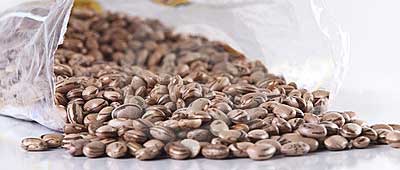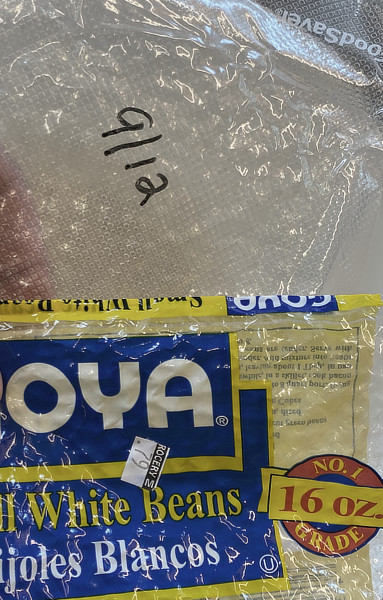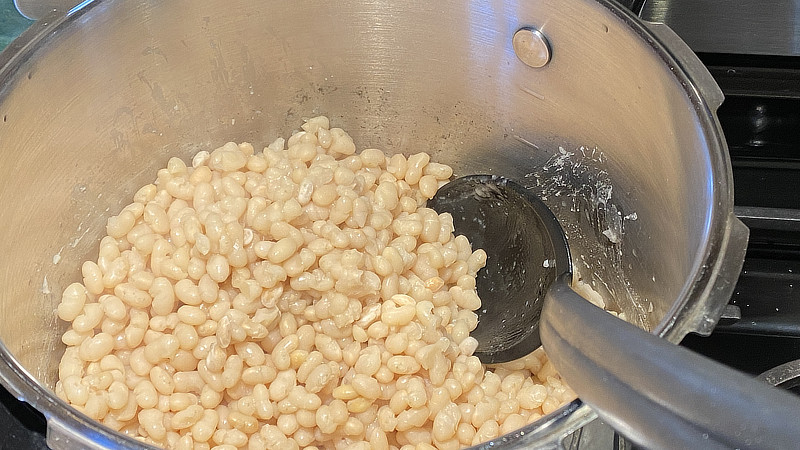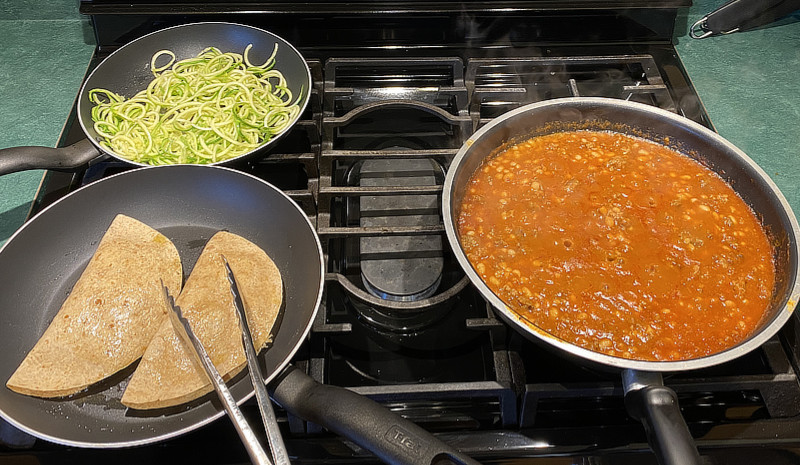Old Dried Beans – Okay To Eat? How To Cook?

This week (during 2022) I checked on a bin of 10 year old dried beans. I had individually vacuum sealed a whole lot of 1-pound bags of beans (within their original packaging). Many of them are now exactly 10 years old, dated 2012. I said to myself, perfect! Let’s try to cook a pound of these old dried beans and see if they’re edible! Especially since I still have lots of them stored away from that era…
I recalled this particular article (copied below after this update) which I published during 2012 on the subject of old dry beans. So I thought it to be great timing… Real world test on these 10 year old beans, and report my findings here on the same original post.
How I Cooked Old Dried Beans
First, here’s a picture of the bag of old white beans which I removed from my vacuum sealed bag. Notice the price tag… 79-cents! What’s it cost now 10 years later?

Next, I dumped them in a bowl, added plenty of water, and let them soak. I soaked them for 4 hours. After that, I drained and rinsed the beans. They definitely soaked up a lot of water (a good sign!)…
Use A Pressure Cooker
Then I dumped them in my pressure cooker. Added water to cover about an inch or two above the beans. I fired up the gas burner. When the jiggler started jiggling, I adjusted the flame for a nice slowish jiggle. Then, the old beans were pressure cooked for 30 minutes. And whadaya know… they came out great!
My 6-Quart Presto Pressure Cooker
(view on amzn)

I know that white beans (e.g. great northern) are soft-and-easy to begin with regarding cooking. Other types of old dried beans may or may not have come out this well. However, I will be trying another batch of different old beans from that bin at some point.
You might be wondering what I did with these old, but yummy, beans… I added them to my zoodle sauce. What are zoodles? They’re zucchini noodles – made from using a spiralizer. I quickly toss and fry up the zoodles with some olive oil. The sauce was a combo of home canned spaghetti sauce, some ground beef, and some hot sausage (and the old beans). Oh boy was it all good!
Mrs. J wanted quesadillas instead…

Okay, back to the original article:
Reader Questions:
I have some pintos and lentils that I put away over 12 years ago that are in their original bags inside of Rubbermaid containers. They look like the day they were purchased. There are no bugs or moisture. However, they have not been stored in ideal temperatures. They have been in garages over 80-90 degrees etc. I doubt that they could sprout anymore, therefore they could not be planted.
My question is this:
Can the old dried beans still be eaten?
Is there any nutritional value left besides filler for the belly?
Are they worth keeping in your opinion simply for fiber?
All I have heard is that ‘old’ beans are tougher when cooked. I assume that means that they do not absorb water like fresh ones and stay a little crunchy!
In addition to those two tubs I have four buckets more of pintos, lentils and peas whose bags were placed inside of white garbage bags and tied closed, and lids put on. These were also stored at incorrect temperatures for many years.
Now I eat beans and legumes regularly but these got ‘lost’ in the back under other things and I moved four times during their storage. The problem with these is that the buckets were not food grade. They were old powder laundry detergent buckets. They had been washed and bleached and rinsed profusely.
I wonder if the food, besides being old and ‘tough’ is safe to eat in an emergency situation.
They are already so old and stored incorrectly, so shouldn’t I just toss them?
I have since learned to rotate my dry goods more often and to store in correct containers in proper temps.
Answer:
I am glad to hear that you are storing food for long term preparedness!
First of all, you are correct that any food needs to be stored properly and at the right temperature (the lower the better), and also, ideally, in the absence of oxygen (and light and moisture).
I will share with you a very similar situation that I had with old dry beans. Some of our beans are stored in sealed Mylar bags and kept inside 5-gallon buckets or regular bin totes.
However, I did have a few bags of dry beans, pinto and black, that were at the back of the pantry shelf for about 5 years. My pantry beans were stored as yours, in their original bags and inside a Rubbermaid container.
One day when I was doing some major ‘spring cleaning’ I discovered the Rubbermaid with the 2 bags of beans inside. Since we mark all of our food, we knew they were 5 years old. We decided, ‘what the heck, let’s try them.’
So after they soaked in water overnight, I cooked them the next day. They were tough, crunchy and not too good… We didn’t eat them. I don’t think they absorbed much water during cooking.
UPDATE: The answer to “How to cook old beans” is using a pressure cooker! The high pressure (and resulting high temperature) cooks them fast and will overcome having to cook them traditionally for a very long time on a stove top (for old hard beans).
[ Read: Rice and Beans – A Survival Combination ]
